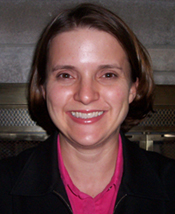I grew up in Auburn, Nebraska which is a town of about 3,400 people. I spent my youth playing music, swimming, showing horses in 4-H, and working in a veterinary clinic. I later attended the University of Nebraska at Lincoln, majored in biology, and took a number of field courses at the UNL's field station (Cedar Point Biological Station) which led me into research. I then studied for a year at Uppsala University in Sweden with Anders Berglund, obtained a M.S. at Michigan State University and Kellogg Biological Station with Tom Getty, and obtained my Ph.D. at Florida State University with the redoubtable Joe Travis.
Rebecca Fuller
Posted on
I have two main research areas. The first centers on the evolution of color patterns, color vision, and sexual selection. I became interested in the evolution of color patterns when I was performing my undergraduate research on grasshoppers in Tony Joern's lab. As part of my research, Tony Joern steered me toward a series of papers that had come out in the American Naturalist in a symposium organized by John Endler and dedicated to sensory drive. A year later, I went to Uppsala University where everyone was excited about the good-genes models of sexual selection. A famous scientist said to me that there was nothing about these sensory systems or sensory environments that would preclude the good-genes model of sexual selection. Ever since, I have been intrigued by these two trains of thought, and I have sought to determine the extent to which sensory drive and sensory bias lead to unique predictions/phenomena that cannot be explained through other models of sexual selection.
My second area of research focuses on speciation. I actually became interested in speciation after obtaining my Ph.D. I was on the job market, and I had back-to-back interviews at the University of Chicago (where Jerry Coyne is a faculty member) and the University of Rochester (where Allen Orr is a faculty member), so I picked up Coyne and Orr's book on Speciation. While I didn't get either of the two jobs, I did have a series of experiments that I wanted to perform before I left my beloved Florida State for the University of Illinois. My doctoral work had focused on the bluefin killifish which is a freshwater species, but its sister species, the rainwater killifish, is a euryhaline species that has an incredibly wide salinity tolerance. The goal of this work is to determine the extent to which adaptation to different salinity regimes itself leads genetic incompatibilities versus the extent to which these genetic incompatibilities crop up subsequently after populations have become isolated. Are genetic incompatibilities important in the early stages of speciation or do they simply provide a lock on a door that was 95% closed already?
I would like to say that I am a very interesting person outside of science, but the reality is that I have two small children. I spend my time away from work playing with my kids, talking to my husband, and weeding our hopelessly weedy garden.
I am probably quite biased in my view of the American Naturalist. Joe Travis was my Ph.D. advisor and was also the editor of the journal while I was in his lab. I saw first-hand Joe's efforts to keep the journal "meaty". During our weekly Travis lab reading group, people would frequently ask, "Are they selling the steak or are they selling the sizzle?" Selling the steak with the sizzle was acceptable, but selling the sizzle without the steak was completely inacceptable. The American Naturalist is a very "meaty" journal that sits at the confluence of ecology and evolution. It's for the big kids who can tackle complex topics, and it's my favorite journal.
